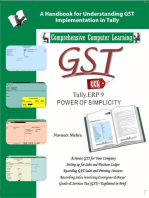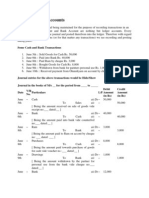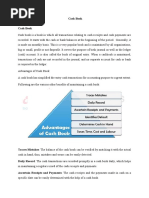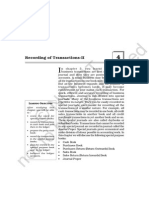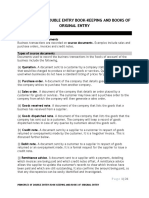Double Entry Cash Book
Double Entry Cash Book
Uploaded by
Gyanish JhaCopyright:
Available Formats
Double Entry Cash Book
Double Entry Cash Book
Uploaded by
Gyanish JhaCopyright
Available Formats
Share this document
Did you find this document useful?
Is this content inappropriate?
Copyright:
Available Formats
Double Entry Cash Book
Double Entry Cash Book
Uploaded by
Gyanish JhaCopyright:
Available Formats
Two/Double Column Cash Book:
Definition and Explanation:
Cash A/c and Bank A/c are two busiest accounts in ledger and they are removed from the ledger to reduce its volume and size. Cash A/c is removed from the ledger and instead of it the Single Column Cash Book is kept to record cash transactions. In the same way no Bank A/c is opened in ledger for recording bank transactions, rather an additional amount column is provided on each side of 'Single Column Cash Book' for recording bank transactions. One more column for amount is provided on the debit side and one on credit side of Single Column Cash Book. These two amount columns on debit side and credit side will serve as Bank A/c and so it will not be necessary to open a Bank A/c in the ledger. The Cash Book having two Amount Columns on both sides is called 'Double Column Cash Book'.
Advantages:
The following advantages are derived from Double Column Cash Book:
1. All entries made in "Bank" Column of Double Column Cash Book form a part of 2.
double entry system and hence a separate Bank A/C need not be opened in ledger. It saves time, labour and cost. Both cash transactions and bank transactions are recorded in the same book. So both cash balance and bank balance are easily available from the same book.
Thus it is said that the Double Column Cash Book has two accounts in it, the Cash A/C and the Bank A/C.
Contra Entry
In any account we can only have one half of a double entry. An account cannot be debited and credited at the same time. For example, when we sell goods for cash, cash received will be recorded on the debit side of Cash Book and the goods sold will be posted on the credit side of Sales Account. But in Double Column Cash Book, we have two accounts, Cash A/c and the Bank A/c, so it is possible to have both a debit entry and a credit entry at the same time. For example, cash of $5,000 is deposited into the bank. In this transaction both Bank A/c and Cash A/c are involved and they will be recorded on both sides of Double Column Cash Book i.e. on the debit side in bank column and on the credit side in cash column. Thus a transaction in which Cash A/c and Bank A/c are involved, is recorded on both the sides of Double Column Cash Book, it is called "contra entry", from the Latin prefix contra meaning 'opposite to or against'. In recording such a transaction the letter "C", is written in 'L.F' column because both aspects of the transactions are recorded and there is no need to post them into the ledger. In this connection, the difference between contra entry and other entries in Cash Book may be noted. ''The Double entry work of contra entry is completed in Cash Book. They need not be posted to ledger". But the double entry work of other entries in Cash Book is not
completed, one aspect (i.e. cash aspect) of the transaction is, however, completed in Cash Book, but the other aspect is not completed, which is to be posted to the concerned account in ledger.
Contra entry will be passed in the following cases:
When cash is deposited into the Bank: Bank column - debit -- Cash column-credit. When cash is drawn from the bank for business purposes: Cash Column - debit -- Bank column - credit. When a cheque received from a debtor on a date subsequent to its receipt is deposited into the bank: Bank column - debit -- Cash column - credit.
Example 1:
Enter the following transactions in a double column cash book/two column cash book.
2005 March 1 March 1 March 3 March 4 March 8 March 10 March 15 March 18 March 20 March 30 March 31 March 31 Cash in hand Bank Balance Received a cheque from Osman Deposited Osman's cheque with bank Withdrawn from bank for business use Goods sold for cash Goods bought for cash Goods sold for cash Paid Rahim by cheque Deposited into bank Paid salary in cash Paid rent by cheque $ 80,000 120,000 24,000 -20,000 30,000 80,000 60,000 26,000 16,000 10,000 6,000
Solution: Double Column Cash Book
Dat Particula e rs 200 5 Mar. Balance 1 b/d 80,000 120,000 V/ N L/ F Cash $ Bank $ Dat Particula e rs 200 5 Mar. Bank A/c 4 (Being cheque deposited ) C 24,000 V/ N L/ F Cash $ Bank $
Osman A/c (Being cheque received) Cash A/c (Cheque deposited with bank) Bank A/c (Being cash drawn from bank) C
24,000
Cash A/c (Being cash withdrawn from bank) Purchase A/c (Being goods bought) Cash A/c
20,000
24,000
15
80,000
20,000
18
16,000
10 Sales A/c (Being goods sold 'for cash) 18 Sales A/c (Being goods sold for cash) 30 Cash A/c (Being cash deposited ) C
30,000
20
Rahim A/c (Cheque issued)
26,000
60,000
31
Salary A/c (Being salary paid) Rent A/c (Being rent paid by cheque)
10,000
16,000
31
6,000
31 Balances c/d
84,000
108,000
214,000
160,000
214,000
160,000
April Balance . 1 b/d
84,000
108,000
You might also like
- Kichesipirini and Kinouchepirini ConfusionDocument3 pagesKichesipirini and Kinouchepirini Confusionapi-3758586100% (1)
- Caring For Muslim PatientsDocument156 pagesCaring For Muslim PatientsPddfNo ratings yet
- Sri City CompaniesDocument20 pagesSri City CompaniesRajan NNo ratings yet
- Three Column Cash BookDocument5 pagesThree Column Cash Bookvinodksrini007100% (2)
- 3 Column Cash BookDocument4 pages3 Column Cash BookMuketoi AlexNo ratings yet
- Visual Reflection RubricDocument1 pageVisual Reflection Rubricapi-317227717No ratings yet
- GST Tally ERP9 English: A Handbook for Understanding GST Implementation in TallyFrom EverandGST Tally ERP9 English: A Handbook for Understanding GST Implementation in TallyRating: 5 out of 5 stars5/5 (1)
- Decoding DCF: A Beginner's Guide to Discounted Cash Flow AnalysisFrom EverandDecoding DCF: A Beginner's Guide to Discounted Cash Flow AnalysisNo ratings yet
- The Effects of Taxation on Multinational CorporationsFrom EverandThe Effects of Taxation on Multinational CorporationsRating: 5 out of 5 stars5/5 (1)
- Recruitment Process Outsourcing A Complete Guide - 2020 EditionFrom EverandRecruitment Process Outsourcing A Complete Guide - 2020 EditionNo ratings yet
- Format of The Petty Cash BookDocument49 pagesFormat of The Petty Cash BookNa Ni63% (8)
- Lecture-2 (Cash Book)Document31 pagesLecture-2 (Cash Book)Ali AhmedNo ratings yet
- What Is A Cash BookDocument4 pagesWhat Is A Cash BookPayal MaskaraNo ratings yet
- Cash Book PDFDocument24 pagesCash Book PDFsavinay agrawal100% (1)
- Cash and Bank AccountsDocument15 pagesCash and Bank AccountsFalola Feyisola Richard100% (1)
- Cash Book: Cash Book Is A Book of Original Entry in WhichDocument10 pagesCash Book: Cash Book Is A Book of Original Entry in WhichCT SunilkumarNo ratings yet
- Cash Book Notes ExamplesDocument17 pagesCash Book Notes ExamplesLycan LycanNo ratings yet
- Unit 5Document6 pagesUnit 5deepshrmNo ratings yet
- Some Cash and Bank TransactionsDocument11 pagesSome Cash and Bank TransactionsSameer ShindeNo ratings yet
- Cash BookDocument2 pagesCash BookfelixmuyoveNo ratings yet
- What Is A Cash Book?: Double/two Column Cash Book Triple/three Column Cash BookDocument7 pagesWhat Is A Cash Book?: Double/two Column Cash Book Triple/three Column Cash BookAiman KhanNo ratings yet
- The Cash BookDocument22 pagesThe Cash Bookrdeepak99No ratings yet
- Cash BookDocument4 pagesCash Booksrisaidegree collegeNo ratings yet
- Subsidary BooksDocument7 pagesSubsidary Booksdevil.work2006No ratings yet
- Financial Accounting Chapter 4Document59 pagesFinancial Accounting Chapter 4abhinav2018No ratings yet
- Cash BookDocument6 pagesCash BookTefo Lelentle Itachi MatlhoNo ratings yet
- Ncert Fm-Ac-xi Chapter 4Document59 pagesNcert Fm-Ac-xi Chapter 4shaannivasNo ratings yet
- Cash and Petty CashbookDocument7 pagesCash and Petty CashbookLycan LycanNo ratings yet
- Accounting For Current Assets - Cash and ReceivablesDocument17 pagesAccounting For Current Assets - Cash and ReceivablesvladsteinarminNo ratings yet
- Ch-5 Cash BookDocument19 pagesCh-5 Cash Bookvel gadgetsNo ratings yet
- 2 Unit 5 Cash BookDocument11 pages2 Unit 5 Cash Bookkingofanimeno.5No ratings yet
- Chapter - 1 Basic Concepts (Accounting Process) : TransactionsDocument8 pagesChapter - 1 Basic Concepts (Accounting Process) : Transactionsgagan vermaNo ratings yet
- Test VII - Cash Book Multiple ChoicesDocument3 pagesTest VII - Cash Book Multiple ChoicesBLACKPINKLisaRoseJisooJennieNo ratings yet
- Cash Book: Cash Book - A Subsidiary Book and A Principal BookDocument6 pagesCash Book: Cash Book - A Subsidiary Book and A Principal BooklatestNo ratings yet
- Accounting Calculations - Learning of FundamentalsDocument7 pagesAccounting Calculations - Learning of FundamentalsRobinHood TiwariNo ratings yet
- © Ncert Not To Be Republished: Recording of Transactions-IIDocument59 pages© Ncert Not To Be Republished: Recording of Transactions-IIIas Aspirant AbhiNo ratings yet
- AccntsDocument24 pagesAccntsAngel SweetNo ratings yet
- Accounting Basics 3Document74 pagesAccounting Basics 3Mukund kelaNo ratings yet
- 7Document14 pages7Anupam GyawaliNo ratings yet
- Types of Accounts and Golden Rule, jOURNAL, LEDGER TBDocument11 pagesTypes of Accounts and Golden Rule, jOURNAL, LEDGER TBlaadla3951No ratings yet
- Double Entry Book Keeping System Notes (Autorecovered)Document6 pagesDouble Entry Book Keeping System Notes (Autorecovered)Hamdi Omar Osman100% (1)
- Fundamental of Accuting Calculation PartsDocument7 pagesFundamental of Accuting Calculation PartsjesseykasiirivuNo ratings yet
- Accounting (Week 3) - Ch. 9Document11 pagesAccounting (Week 3) - Ch. 9junkmail4akhNo ratings yet
- O Levels Accounting NotesDocument10 pagesO Levels Accounting Notesoalevels90% (20)
- Module 2Document41 pagesModule 2Sujata SarkarNo ratings yet
- Note 5 The Cash Book IIDocument11 pagesNote 5 The Cash Book IItachorielNo ratings yet
- Explain Bank Reconciliation Statement. Why Is It PreparedDocument6 pagesExplain Bank Reconciliation Statement. Why Is It Preparedjoker.dutta100% (1)
- Subsidiary BooksDocument7 pagesSubsidiary BooksRashmi PatelNo ratings yet
- Ch-3 LEDGERDocument7 pagesCh-3 LEDGERvel gadgets100% (1)
- Grade 11 - Cbse-Chapter 4 Recording of Transaction IIDocument42 pagesGrade 11 - Cbse-Chapter 4 Recording of Transaction IIhum_tara1235563No ratings yet
- Chap - 13 (Cashbook)Document3 pagesChap - 13 (Cashbook)7a4374 hisNo ratings yet
- Lecture FiveDocument32 pagesLecture Fivebeysam240No ratings yet
- CBSE Class 11 ACCOUNTANCY Chapter 6 Ledger and Trial Balance Revision NotesDocument5 pagesCBSE Class 11 ACCOUNTANCY Chapter 6 Ledger and Trial Balance Revision NotesBinoy TrevadiaNo ratings yet
- Chapter 13Document2 pagesChapter 13Hasib QureshiNo ratings yet
- Bank Reconciliation Statement (BRS)Document15 pagesBank Reconciliation Statement (BRS)TheerthuNo ratings yet
- State Whether The Following Statements Are TRUE or FALSE 1. Total of Payments Side Can Be Greater Than Total of Receipts Side IDocument1 pageState Whether The Following Statements Are TRUE or FALSE 1. Total of Payments Side Can Be Greater Than Total of Receipts Side Iminharahmath55No ratings yet
- BY: Ms. Pakeezah ButtDocument31 pagesBY: Ms. Pakeezah ButtHusnain MustafaNo ratings yet
- Double Entry BookkeepingDocument26 pagesDouble Entry BookkeepingarthurNo ratings yet
- Mba Faaunit - IIDocument15 pagesMba Faaunit - IINaresh GuduruNo ratings yet
- Influence of Nitrogen and Phosphorus On The Growth and Yield of Cucumber (Cucumis Sativus L.)Document13 pagesInfluence of Nitrogen and Phosphorus On The Growth and Yield of Cucumber (Cucumis Sativus L.)Emmanuel Bassey EffaNo ratings yet
- Chap7 - Flow Pattern For Multi Phase FlowDocument33 pagesChap7 - Flow Pattern For Multi Phase FlowSyazreen AminNo ratings yet
- ACTION PLAN in YES-o 2022-2023Document17 pagesACTION PLAN in YES-o 2022-2023Josephine Gonzales Basilio-De VeraNo ratings yet
- Critical Care Notes BookDocument142 pagesCritical Care Notes BookDerick RanaNo ratings yet
- Reservoir Characteristics: The Primary Reservoir Characteristics That Must Be Considered IncludeDocument52 pagesReservoir Characteristics: The Primary Reservoir Characteristics That Must Be Considered Includehussein alsaedeNo ratings yet
- 1 Strategic Financial ManagementDocument12 pages1 Strategic Financial ManagementYashika KapdiNo ratings yet
- Grammar: Articles A, An, TheDocument34 pagesGrammar: Articles A, An, TheMaria Beatriz SouzaNo ratings yet
- World War II - Winter 2024 USADocument84 pagesWorld War II - Winter 2024 USAOscar ValladaresNo ratings yet
- Grade 11 Reco ScriptDocument2 pagesGrade 11 Reco ScriptCecill Nicanor LabininayNo ratings yet
- Suman Sahu, Et AlDocument10 pagesSuman Sahu, Et AlJatin SinghNo ratings yet
- 26855-Article Text-58520-1-10-20181030Document7 pages26855-Article Text-58520-1-10-20181030ogieNo ratings yet
- Feasibility Study For Assembly of Bicycle Project Proposal Business Plan in Ethiopia. - Haqiqa Investment Consultant in EthiopiaDocument1 pageFeasibility Study For Assembly of Bicycle Project Proposal Business Plan in Ethiopia. - Haqiqa Investment Consultant in EthiopiaSulemanNo ratings yet
- Governance What Is Governance?Document7 pagesGovernance What Is Governance?Alia KoolKatNo ratings yet
- Central Warehousing Corporation Recruitment 2024Document5 pagesCentral Warehousing Corporation Recruitment 2024swagatrs01No ratings yet
- Harbach 2011Document14 pagesHarbach 2011Olawuyi Boluwatife ComfortNo ratings yet
- Land Development MethodDocument7 pagesLand Development MethodSatrio MangkunegoroNo ratings yet
- Wondershare QuizCreatorDocument2 pagesWondershare QuizCreatorafdal syukriNo ratings yet
- The State of The World's Children 2011: Adolescence - An Age of OpportunityDocument148 pagesThe State of The World's Children 2011: Adolescence - An Age of OpportunityUNICEF100% (2)
- DDD - Assignment - BKC18368Document28 pagesDDD - Assignment - BKC18368Hieu DoNo ratings yet
- Education & Learning Vocabulary (Arabic)Document1 pageEducation & Learning Vocabulary (Arabic)Mourad Diouri100% (2)
- 1.2 Scientific MethodDocument6 pages1.2 Scientific MethodyeopeeNo ratings yet
- Cuwizard: What'S The Object of The Game?Document10 pagesCuwizard: What'S The Object of The Game?Greg RobinsonNo ratings yet
- Hanna Yo TecnoDocument5 pagesHanna Yo TecnoMANUEL ALEJANDRO JUAREZ MOLINANo ratings yet
- 2003 ExamDocument10 pages2003 ExamBibek Raj100% (1)
- The Motion Pictures Ordinance 1979Document7 pagesThe Motion Pictures Ordinance 1979Ali RajNo ratings yet
- Communication in Distributed SystemDocument58 pagesCommunication in Distributed Systemvinaya23No ratings yet







